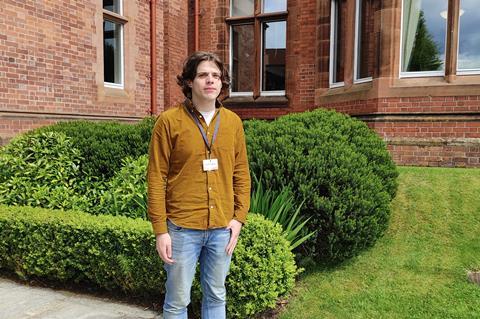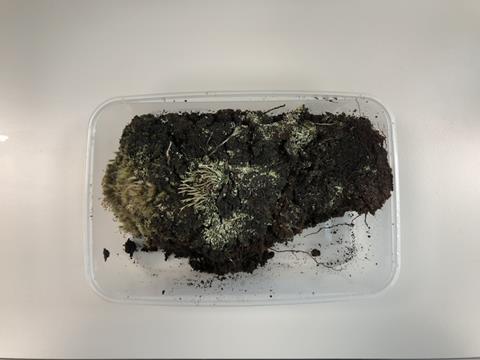Microbes discovered in a peat bog could be used to break down plastic pollution, research being carried out at Queen’s University Belfast has revealed.
PhD student Scott Coughlin presented his work on how soil microbes might help to solve the issue of microplastic pollution at the recent Letters in Applied Microbiology ECS Research Symposium at Riddel Hall in Belfast, prompting a blizzard of questions from a roomful of fascinated delegates.

As part of this work, he has sampled various natural environments to search for plastic-degrading microbes and uncovered a possible enzyme system which may be involved in the breakdown of polypropylene.
“Microplastics have become virtually ubiquitous across most of Earth’s biomes, dispersing over vast geographic areas. Scientific predictions, which consider progress and innovations in recycling and replacement materials, estimate 1.3 billion tonnes of plastic pollution globally by 2040,” he tells The Microbiologist.
Far-reaching impacts
“Microplastics act as a vector for antimicrobial resistant bacteria and other pathogenic microbes. The polymers, and their additives, inhibit growth and alter community dynamics of microorganisms at the base of food webs, which in turn could have far-reaching impacts on the biodiversity of ecosystems.
“My work evaluates the plastic-degrading activities of microbes indigenous to habitats containing high quantities of plant polymers (such as cellulose and lignin), and polymers derived from insects and fungi (such as chitin).
“Where plastic-degrading activities were detected, I quantified the rate at which the plastic was being degraded by the microbe, aiming to answer the question of whether these microbes, or their enzyme systems, could be used to remediate plastic-polluted sites.”
For the study, Scott sampled environments containing these plant polymers, including a peat bog, domestic compost, lake sediment and reedbed mud, making a suspension of these in saline solution and incubating with different synthetic plastics as their only available carbon and energy source.

“The plastics were low-density polyethylene, polypropylene, polystyrene, and poly(ethylene terephthalate) (PET). I could select microbes based on their ability to grow in such a nutrient and energy-restricted environment,” he explains.
“I isolated the bacterial species and grew them in the presence of accurately weighed high-purity plastic films for 28 days. Whilst bacterial isolates may have been able to colonise the plastic films, only a few could actually degrade them.
Three bacterial species
“From these experiments, I found three bacterial species from the peat bog and compost samples which rapidly degrade polypropylene and polystyrene (up to 22.7% mass loss of plastic over 28 days).
“Whole genome sequencing, along with BLAST searches of the few known plastic degrading enzymes, revealed an enzyme in one of these microbes that is known to degrade long chain alkanes such as n-hexadecane. This enzyme was successfully expressed in E. coli, and current work will characterise the enzyme (without the living cells) in terms of rate and kinetics.”
Scott concedes that the issue of plastic pollution is complicated because of the size of the particles that cause issues, but points out that this work has characterised a microbe that rapidly degrades polypropylene, one of the most polluting plastics in Earth’s biosphere.
“It is likely that there are more microbes like this in the environment, and there is possibly scope that microbial and enzymatic systems could be used to reduce the amount of plastic contamination in polluted sites,” he says.
Ester linkages
In the scientific literature, biodegradation of polyethylene and polystyrene aren’t as well characterised as some other plastics, such as PET. What did intrigue Scott was that the ester linkages between the monomers in the PET structure are more readily hydrolysed than the carbon-carbon bonding in polyethylene and polystyrene.
“It is interesting that the most rapid plastic-degrading microbes I found degrade these plastics. This is probably owing to metabolic systems associated with oxidation and breakdown of alkanes but is it certainly surprising to find microbes with these capabilities in non-polluted environments,” he says.
Further work, Scott says, is needed to characterise the enzyme systems involved in the breakdown of these plastics.
“In the case of PET degradation, a lot has been done in relation to enzyme engineering (e.g., site-direct mutagenesis) to make the degradation pathway occur at a higher rate, in a much more thermostable and cell-free context,” he says.
“A similar approach could be adopted on the enzyme from this project, with the aim of completely depolymerising the plastic into its constituent monomers, which could either be mineralised into microbial biomass, or possibly recycled to generate new plastic, without the need for processing crude oil.”
Scott’s supervisor team at Queen’s University Belfast, Dr Julianne Megaw and Dr Stephen Kelly have been instrumental in guiding this project and applying their expertise in diverse scenarios. The project is funded by a PhD Studentship from DAERA NI.







No comments yet